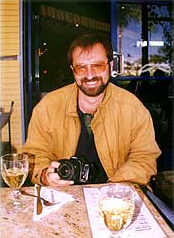Dr. Alexander “Sasha” Kashlinsky
The NewScientist article Galaxy flow hints at huge masses over cosmic horizon said
“Hundreds of clusters of galaxies are streaming en masse towards a region at the edge of the visible universe. The discovery has taken astronomers completely by surprise because the movement is independent of the universe’s expansion.A team led by Alexander Kashlinsky of NASA’s Goddard Space Flight Center in Greenbelt, Maryland, stumbled upon the flow while studying how galaxy clusters affect the photons of the cosmic microwave background (CMB), the radiation left over from the big bang.
Kashlinsky has dubbed the stream ‘dark flow’ to align it with the other as yet-unexplained characteristics of the universe, dark matter and dark energy.”
Alexander “Sasha” Kashlinsky, Ph.D. is Senior Staff Scientist, NASA Goddard Space Flight Center. His scientific interests include cosmology, galaxy formation, large-scale structure of the Universe, cosmic microwave background, and cosmic infrared background radiation. He is a PI on several NASA and NSF grants to study topics related to bulk flows and cosmic microwave background radiation, and to cosmic infrared background and early stellar populations.
Sasha authored Cosmic Infrared Background from Early Epochs — Searching for Signatures of the First Stars and Imprint of first stars era in the cosmic infrared background fluctuations, and coauthored Measurement of the electron-pressure profile of galaxy clusters in Wilkinson Microwave Anisotropy Probe (WMAP) 3-year data, A measurement of large-scale peculiar velocities of clusters of galaxies: results and cosmological implications, Demonstrating the negligible contribution of optical ACS/HST galaxies to source-subtracted cosmic infrared background fluctuations in deep IRAC/Spitzer images, and Exploring First Stars Era with GLAST.
He studied Physics at Latvian State University, Riga, USSR/Latvia from 1973 to 1976 and completed his B.Sc. in Physics at Tel Aviv University, Tel Aviv, Israel in 1977. He earned his M.Sc. in Physics at Tel Aviv University, Tel Aviv, Israel in 1979. He earned his Ph.D. in Astrophysics at the Institute of Astronomy, University of Cambridge, England in 1983 with the thesis “The formation of bounds systems in the Universe” where his supervisor was Lord Martin Rees.
